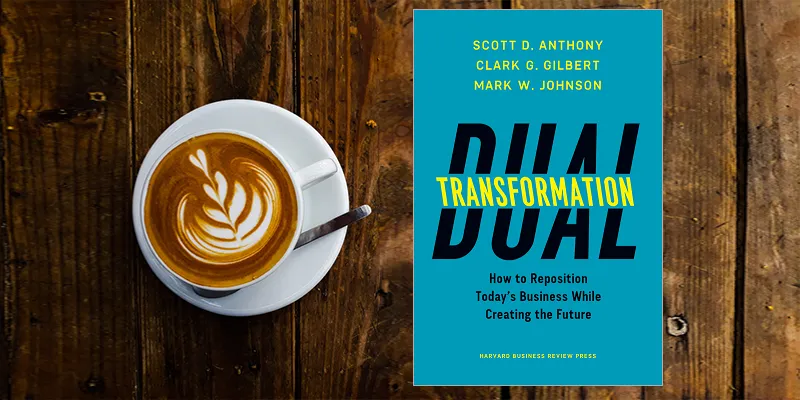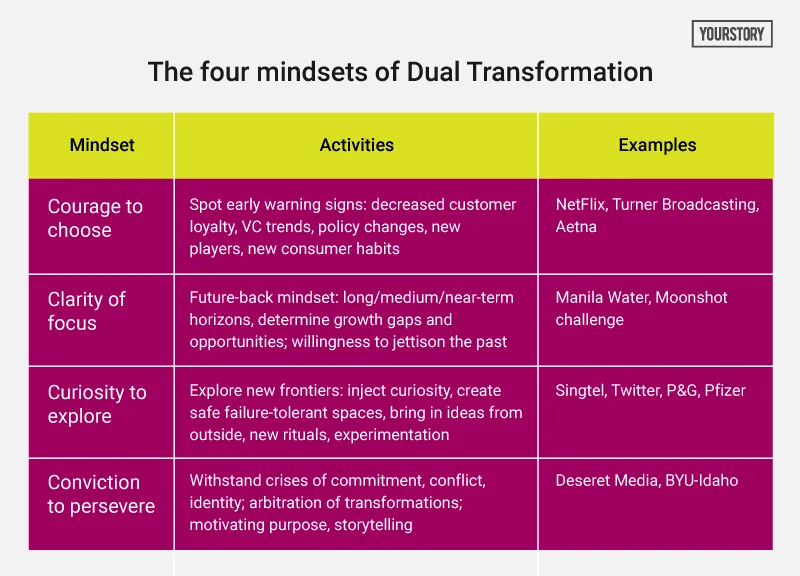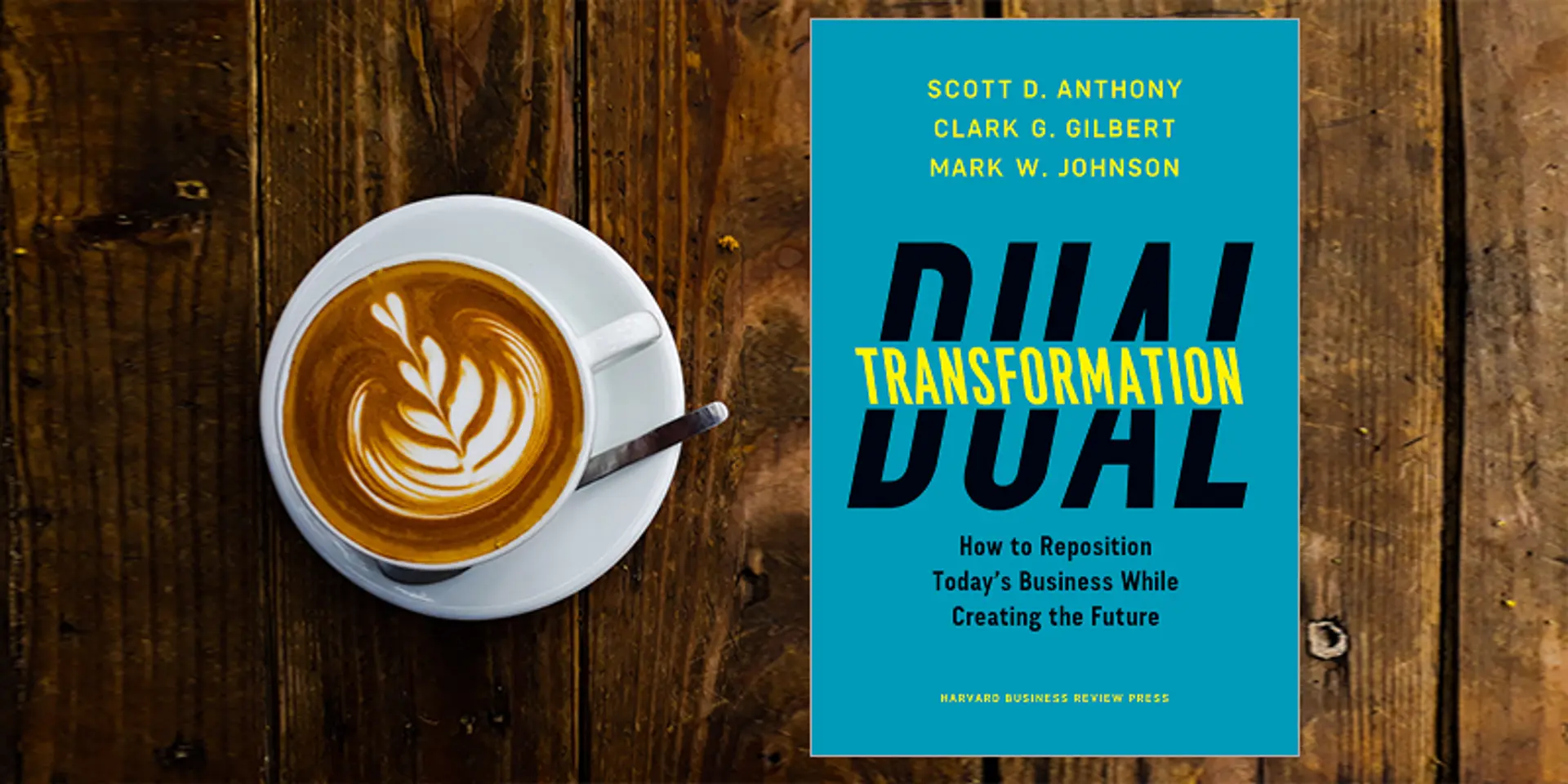Dual transformation: the four mindsets for innovating on current and emerging business models
In the face of disruption, companies need to reinvent themselves for new terrain – while also retaining some of their earlier core advantages, as this book explains. Successful startups of today will become the incumbents of tomorrow, and need to keep their creative edge alive on multiple fronts.
How to manage synergy across parallel business tracks is the focus of the book, Dual Transformation: How to Reposition Today's Business While Creating the Future, authored by three innovation experts.

Scott Anthony is the managing partner of innovation consultancy Innosight, and author of The Little Black Book of Innovation and The First Mile: A Launch Manual for Getting Great Ideas into the Market. Mark W. Johnson is a cofounder and senior partner at Innosight. Clark Gilbert is the president of BYU-Idaho and the former CEO of Deseret News Publishing and Deseret Digital Media.
The core of the book revolves around the four mindsets of dual transformation: the courage to choose, clarity to focus, curiosity to explore, and conviction to persevere. These are illustrated via examples from multiple industry sectors, such as Netflix, Adobe, Amazon, Twitter, Xerox, SingTel, Ford, and Manila Water.
The nine chapters are spread across 250 pages, and make for an informative and practical read. The online companion offers tools and checklists like leadership discussion questions, curiosity assessment map, transformation blueprint, and disruption tracker.
Here are my key takeaways from the book, summarised in Table 1 (below) as well. See also my reviews of the related books The Startup Way, Making Innovations Happen, People with Purpose, Human + Machine, and The Subscription Economy.
Leading transformation in a time of disruption is “the greatest opportunity a leadership team will ever face,” the authors emphasise. “Disruption opens windows of opportunity to create massive new markets,” they add.

I. Foundations
Successive waves of innovation cause companies to embrace “circles of disruption”.
Operating in dual modes is tough, and many companies have failed along the way, such as Kodak. Other leaders unseated by the “gale of creative destruction” include Borders bookstores, Nokia and RIM (Blackberry).
The speed of innovation is also being accompanied by the speed of extinction. Kodak’s woes took 40 years to play out, many newspapers had only a dozen years of life after the Internet shock, and Nokia and RIM were ripped apart in just five years, the authors point out. But disruption also opens up opportunity for startups – and incumbents savvy enough to adapt and reinvent, such as the move away from desktops by IBM and Apple.
The authors describe this shift through three components. Transformation A is repositioning and improving the business model to maximise resilience (eg. Adobe moving from packaged software to SaaS). Transformation B is creating a new growth engine (eg. Amazon adding cloud computing services, digital publishing, and streaming content on top of ecommerce). The Capabilities Link involves building on the relevant mix of critical assets, brand and scale, and managing the interface between the core and the new.
Transformation A involves accepting changed circumstances, devising new metrics, and bringing in fresh talent experienced in emerging work environments. Transformation B requires understanding consumption journeys, maps, frequencies, and value patterns. This helps develop new business models through iterative experimentation and willingness to pivot. This may involve acquiring other companies and forging new partnerships, depending on expectations of impact periods.
The authors liken the capability link to an airlock in a spaceship or submarine. This team includes savvy veterans and diplomatic managers, but the business leader will need to drive hard decisions on which core skills are relevant during transformation, and arbitrate during the inevitable arguments and turf wars.
Tough calls will need to be made regarding speed of operation, pricing options, and assessing some of the inevitable failures along the way. Other challenges in dual transformation are balancing attention and assets, and protecting traditional income streams while also growing new sources in a slow and experimental manner.
Transformation should happen before the need is obvious. Companies are good at mapping traditional competitors, but not newly emerging players and potential disruptors. Challenges for incumbents lie in going beyond incremental ideas and basic line extensions to truly innovative spaces.
Unfortunately, companies that rely too much on predictable standard operating procedures may bury the spirit of curiosity, the authors caution. “Business leaders have two fundamental challenges. They must exploit what they currently have, and they must explore what they don’t have,” they explain.
Business leaders must create separate governance structures to value emergent learning, treat new ideas separately, and create a culture of curiosity. This also involves “getting out of the building” to get new stimuli on the ground and connect with the field.
Commitment and patience are needed to stick to entrepreneurial mode and get past fumbles and false starts; it takes time to build a new business. Mental flexibility is needed to operate in the dual stable as well as startup modes.
Also read: Intrapreneurs could drive the next wave of innovation in the entrepreneurial ecosystem. Here’s how
II. Examples
Disruptors who changed their domains include Huffington Post and SalesForce.com. They addressed the same problems as the incumbents, but in a better way. Google began with search then expanded into advertising; it later restructured with Alphabet as the parent conglomerate.
Twitter emerged as a side project of podcasting company Odeo. Pfizer capitalised on the side-effects of its drug UK-92480 and created Viagra. “Predictable” companies would have shut down such failures and side projects, and not explored them the way innovative companies do.
Netflix was launched in 1998 on the business model of renting individual DVDs, then moved on to a subscription-based model. It refined tools such as its recommendation engine, and then augmented its business with internet streaming and creating original content as well, riding trends like binge-watching.
Adobe reinvented itself during the 2008-2009 recession and moved to the SaaS model, first testing it with PhotoShop Express. It then launched Creative Cloud, and discontinued physical products. For Transformation B, it expanded into digital marketing solutions through a range of acquisitions.
Xerox was founded in 1906 and became an iconic company, but was sidelined by the rise of competitors and digital media. It created a new growth engine in business process automation under the brand Xerox Global Services, buying up companies like ACS. It then split into two companies: one selling photocopiers and printers, and the other a BPO firm called Conduent.
Johnson & Johnson acquired Janssen Pharmaceuticals, and worked with external scientists and startups via incubators. These moves significantly increased early-stage deals and improved reputation in the innovation community. The company also developed capabilities in disease interception, which involves working with consumer product firms with new business models.
Manila Water used the future-back approach to map out emerging scenarios and work backwards to categorise business opportunities. It decided to stay out of the energy and advertising business, and targeted commercial wastewater management and packaged water.
Aetna reinvented its insurance business by helping patients better manage their own health and offering value-based contracts. Walgreens is augmenting its medicine stores with clinics and integrated ecommerce to expand into the healthcare sector. Medtronic made progress in the Indian market by forming deeper ties with hospitals and doctors, and offering financial loan programmes for pacemakers.
SingPost (Singapore Postal Service) transformed itself from a mail carrier to a logistics and ecommerce fulfillment provider. After its IPO, it also added B2B mailroom management and BPO capabilities.
SingTel grew to become Southeast Asia’s largest mobile provider, but also expanded into advertising and cybersecurity through acquisitions. It overcame the “problems of predictability” by promoting external ideas (eg. invited speakers) and overseas immersion visits (eg. holding top management workshops in China, India, Silicon Valley).
SingTel created a special organisation called Group Digital L!fe and an investment vehicle called SingTel Inov8; some of its portfolio startups (Viki, Jasper) were also acquired (by Rakuten, Cisco). It organises a Learning Fiesta to expose employees to new ideas and event formats like hackathons. Employees are rotated between functions and roles to further spur the “curiosity quotient” and empathy.
Globe Telecom in the Philippines has moved into corporate venture capital as well. Optus organises immersive “customer close-ups” and shadowing of sales reps to give employees first-hand exposure of customer realities. Ideas are shared at meetings even if they are half-baked, so that fragments of the ideas can be combined with others and taken in new directions.
Tata Sons promotes and celebrates innovative and risk-taking behaviours through its “Dare To Try” awards. They are given for novel, daring, and seriously-attempted ideas that eventually did not work out.
Ford is improving its core automotive business while also creating a new mobility services business where non-traditional competitors have emerged. Thinking too much of its century-old past can lead to an “abyss of paralysis”, according to its CEO Mark Fields.
BYU-Idaho repositioned itself with the needs of students as the centre of its purpose, and added a strong offering in online learning over and above campus teaching. Arizona State University leveraged the online medium to reach out to non-traditional students.
Turner Entertainment Networks rode the media disruption storm by investing in original content, negotiating with affiliates, offering contextual advertising and in-show product placement, and running offline events.
The Deseret Media group opened up a new digital organisation in addition to its traditional print newspaper. It refocused the print group on faith-oriented content and communities, and also launched a series of digital marketplaces. The revitalised group benefited from new growth business as well as a repositioned and stabilised core. It brought down costs by outsourcing some content and roping in stringers.
Also read: Entrepreneur, intrapreneur: 15 tips on how large firms can tap innovators
III. The road ahead
The book ends with leader profiles and insights of the companies featured above. Leaders need to frame the vision, spur thought-provoking discussion, ensure clarity, inspire action, and “grow new muscles” for the company.
“Transformation is a roller-coaster ride,” says Helen Eaton, Executive Director Settlement Music School; it is complex and inspiring. Dual transformation can give employees new excitement by having them work across both entities, according to Gerry Ablaza, CEO, Manila Water.
“The most important thing is to be open to new ideas. If you are very successful in what you have been doing, it is sometimes even more difficult to want to change,” cautions Chua Sock Koong, CEO, SingTel.
Leaders need to create and handle the important dialogues and conversations about assumptions and risks as companies move away from certainty and predictability to untested waters, urges Mark Fields of Ford. “Transformation is uncomfortable and exciting at the same time,” he adds. It can be scary and tense to have two conflicting thoughts in the mind at the same time.
“Communications is a big deal in changing any culture. Culture trumps strategy every day of the week,” says Michael Crow, President, Arizona State University.
The authors also identify five sectors ripe for disruption in the next few years: consumer banking, shipping, medical devices, automobile manufacturing, and professional services. Tech drivers include mobile media, 3D printing, IoT, wearables, AI, and platforms (see my reviews of the related books AI Advantage and Machine, Platform, Crowd).
“Remember, disruption grows markets, even as it transforms business models,” the authors sign off. In sum, the book is a valuable resource for business leaders on how to operate and succeed in dual tracks; this even applies to individuals in how to prepare themselves for the future of work.









